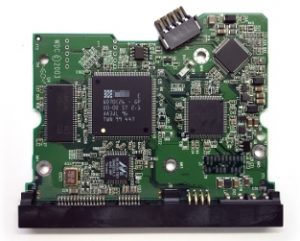Many modern hard drives have a Read Only Memory (ROM) chip on their printed circuit boards (PCBs). The ROM contains firmware, which allows the hard drive to communicate with your computer.
 Within the data recovery industry, the term ROM chip may be used to refer to a range of technologies including EEPROM (Electrically Erasable Replaceable Read Only Memory) or NVRAM (Non-Volatile Random Access Memory) depending on the technology used.
Within the data recovery industry, the term ROM chip may be used to refer to a range of technologies including EEPROM (Electrically Erasable Replaceable Read Only Memory) or NVRAM (Non-Volatile Random Access Memory) depending on the technology used.
Regardless of the tech, the chip’s main purpose is to store calibration data that is written at the factory. The data contains adjustments for the hard drive’s individual characteristics. In other words, the data is specific to the hard drive with that particular ROM chip — if you switch the ROM with another hard drive’s ROM, neither hard drive will function.
This is because modern hard drives require an extraordinary level of precision. The hard drive’s operating instructions must account for slight differences in the read/write head spacing or the thickness of the platter materials; otherwise, it cannot locate, read, or write data.
Below, we’ll address some common questions about hard drive ROM chips. For help with data loss, call 1-800-237-4200 or schedule a risk-free media evaluation online.
If my hard drive fails, can I replace the ROM chip?
No — and it’s important to note that in most cases, the ROM chip is not the failed component. Read/write head failures, PCB failures, and other physical issues are much more common than ROM damage.
Replacing the ROM chip won’t work, because your hard drive needs to operate with the calibrations it received at the factory.
Related: Can a Hard Drive Be Repaired?
Can I replace the PCB, then swap the old ROM to the new board?
Professional data recovery engineers may perform a chip swap as part of their process. In other cases, the operating instructions from the old board can be copied and transplanted onto the new board without transferring the physical chip, or the firmware may need to be adjusted (revised) with specialized hardware.
We do not recommend at-home data recovery for situations in which data is irreplaceable. Generally speaking, you have one chance to recover your data successfully. If you make a mistake when switching your ROM to a new board — or if the issue is not related to the PCB in the first place — you risk permanent data loss.
If you’re dead set on performing a ROM swap or PCB swap, you’ll need a thorough understanding of Surface Mounted (SM) electronics and a hot air station, not a soldering iron.
If you don’t have significant experience with SM components, do not attempt this. When the ROM is damaged, data recovery becomes extremely difficult (and in some cases, impossible).
Related: Can Static Electricity Really Destroy a Hard Drive?
For best results, work with a professional data recovery provider.
To diagnose and repair hard drives, engineers need extensive training and years of hands-on experience. If you cannot replace the data on a failed hard drive, the best course of action is to work with reputable data recovery specialists.
At Datarecovery.com, we’ve invested heavily in research and development. At each of our locations, we maintain a large hard drive parts inventory and fully equipped laboratories with dedicated firmware repair equipment.
Our services are designed to provide peace of mind as your case progresses. All hard drives are eligible for a risk-free evaluation, which identifies the cause of data loss and provides a price quote and turnaround estimate. Additionally, we support all cases with a no data, no charge guarantee: If we’re unable to recover the files you need, you don’t pay for the attempt.
To get started, submit a case online or call 1-800-237-4200 to speak with a data recovery expert.





